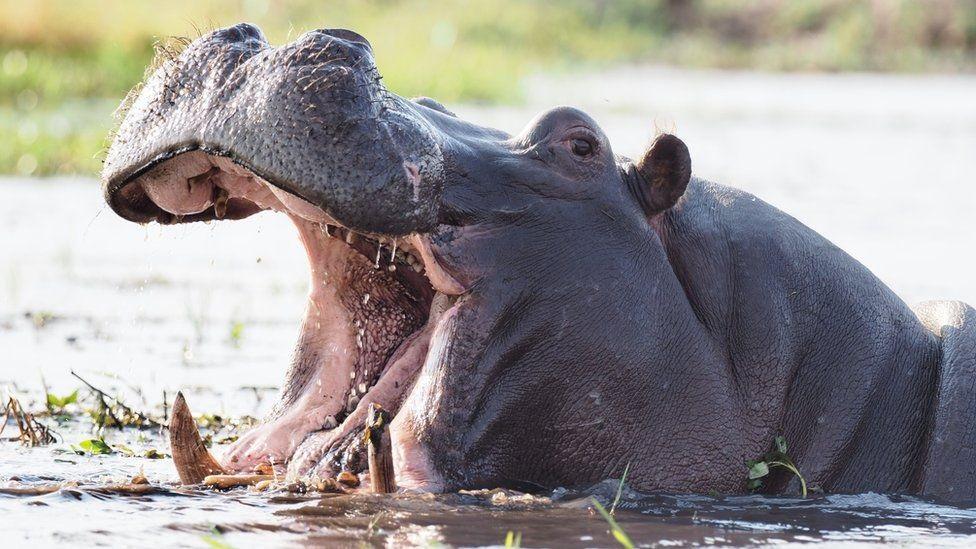Africa-Press – Mozambique. Scientists say hippos can communicate with each other and tell the difference between the honking sounds of their friends, neighbours and strangers. Until now, the function of the loudest and most common hippo calls, known as “wheeze honks”, has been a mystery.
Rresearchers recorded hippo sounds at a nature reserve in Mozambique and broadcast the recordings through loud speakers over lakes. They found hippos responded differently to friend and foe, suggesting they could tell each other apart.
The lead scientist Nicolas Mathevon says the knowledge could help in the conservation of hippos, which are not yet endangered, but whose numbers are falling fast.
Wild hippos are noisy creatures, their calls travelling long distances across lakes and rivers.
But until now the precise function of the loud “wheeze honks” the animals make has been a mystery.
Scientists studying hippos at a nature reserve in Africa – the Maputo Special Reserve, in Mozambique – say the distinctive honks enable the large mammals to tell friend from foe.
And the team says the animals can probably recognise individuals from their “voices”.
Study leader, Prof Nicolas Mathevon, from the University of Saint-Etienne, in France, has studied the sounds animals make across the world, from leopard seals to hyenas.
He said hippos have a wide vocal repertoire, including grunts, bellows, squeals and “wheeze honks”, but very little is known about their social communication.
“In their call, there is information about the identity of the individual – so they have ‘voices’ – and they are able to recognise each other by their voices,” he said. “This recognition ability supports the social relationships between individuals.”
Hippos at Maputo Special Reserve, Mozambique. The area has a number of lakes with different hippo populations [Photo: Nicolas Mathevon]
To find out more about hippo communication, French researchers recorded the sounds of hippos living in the Maputo Special Reserve in Mozambique.
The wheeze-honk is the most common hippo call and the loudest- travelling as far as 1km, according to the study.
The biologists recorded the wheeze-honks of hippos and broadcast these from the shore of lakes to see how other individuals responded.
They found hippos could tell apart friends, neighbours and strangers from their voices. In addition to telling apart friend from foe (or, at least, unfamiliar hippos), the animals can probably distinguish between individuals, according to the researchers – though they can’t be absolutely certain of this.
And despite appearing to be lounging around on the water, the large mammals were clearly paying close attention to their surroundings and responded immediately to the broadcasts.
The animals responded more aggressively to unknown hippos – with quicker, louder and more frequent calls, often accompanied by territorial displays of dung spraying.
Prof Mathevon said it was important to learn more about the biology and behaviour of hippos to help avoid human-animal conflicts.
The knowledge might also assist with conservation, he said, as wild hippos are sometimes moved from one location to another to keep local populations healthy.
The work may inspire conservationists to make recordings to allow local hippos to get used to the voice of the new ones before they arrive, he added.
Hippos are not yet endangered in the wild, but their numbers are plummeting fast. They are a source of animal-human conflict, with hippos causing hundreds of human deaths a year.
The research was published yesterday in Current Biology.
Julie Thévenet,
Afiliations: Equipe de Neuro-Ethologie Sensorielle ENES/CRNL, University of Saint-Etienne, CNRS, Inserm, Saint-Etienne, France. Equipe Cognition Auditive et Psychoacoustique CAP/CRNL, University Lyon 1, CNRS, Inserm, Lyon, France
Nicolas Grimault,
Afiliations. Equipe Cognition Auditive et Psychoacoustique CAP/CRNL, University Lyon 1, CNRS, Inserm, Lyon, France
Paulo Fonseca.
Corresponding author. Co-senior authors. Affiliations: Departamento de Biologia Animal and cE3c — Centre for Ecology, Evolution and Environmental Changes, Faculdade de Ciências, Universidade de Lisboa, Lisbon, Portugal
Nicolas Mathevon.
Co-senior authors. Lead contact. Affiliations: Equipe de Neuro-Ethologie Sensorielle ENES/CRNL, University of Saint-Etienne, CNRS, Inserm, Saint-Etienne, France. Institut Universitaire de France, Paris, France.
Summary
Planet Earth is becoming increasingly difficult for large animal species to inhabit. Yet, these species are of major importance for the functioning of the biosphere and their progressive disappearance is accompanied by profound negative alterations of ecosystems1 (Supplemental information). To implement effective conservation measures, it is essential to have a detailed knowledge of the biology of these species. Here, we show that the hippopotamus Hippopotamus amphibius, an iconic African megaherbivore for which little is known about social communication, uses vocal recognition to manage relationships between territorial groups. We conducted playback experiments on groups of hippos and observed their response to vocalizations from an individual of the same group (familiar), a group from the same lake (neighbor) and a distant group (stranger). We found that stranger vocalizations induced a stronger behavioral reaction than the other two stimuli. In addition to showing that hippos are able to identify categories of conspecifics based on vocal signatures, our study demonstrates that hippo groups are territorial entities that behave less aggressively toward their neighbors than toward strangers. These new behavioral data suggest that habituation playbacks prior to conservation translocation operations may help reduce the risk of conflict between individuals that have never seen each other.
Main text
The megaherbivores — terrestrial mammals that feed on plants and weigh over 1000 kg (elephants, hippos and rhinos) — are a major source of concern. Rhinos remain critically endangered2. Elephants are also under pressure from human activities, yet our extensive knowledge of their biology allows conservationists to devise appropriate management measures3. The third African megaherbivore, the hippopotamus, is not yet listed as endangered, but its populations have declined dramatically in recent decades4. This amphibious animal shares its life between land and water and has a unique role in the ecosystem mainly because of its impact on the flux of energy and matter between the two environments5. The biology of the hippopotamus is still mysterious in many respects, and population management methods remain largely empirical6.
Studying the behavioral biology of hippos in the wild is complicated. It is difficult, if not impossible, to identify and mark individuals and sometimes highly challenging to locate them. Hippos feed on land mainly at night and are rather solitary. During the day they gather in groups in the water. Hippo groups are socially structured around a dominant male, a variable number of females and their young, and some peripheral males7. However, it is unclear whether individuals in a pod form a stable group defending a territory or pods are organized in a fission-fusion manner with individuals moving from one pod to another. In any case, the hippo social system appears to rely on communication signals — hippos are very vocal — whose role and meaning remain almost unexplored8.
Here, we focused on the most common hippo vocalization, the ‘wheeze honk’, a loud call heard over long distances that is assumed to be important for social cohesion and communication between groups, but whose actual function remains unknown (Supplemental information). Based on the assumption that hippo groups are territorial entities, defended by the dominant male but also potentially by other individuals, including females, we tested the hypothesis that the wheeze honk could signal the identity of the sender and thus enable behavioral decisions by the receiver individuals.
We worked in the Maputo Special Reserve (Mozambique; Figure 1A). For each group of hippos (minimum number of individuals = 3; maximum = 22), we first recorded spontaneous vocalizations and then conducted playback experiments (Supplemental information).
We conducted three types of playback test on groups of hippos: one with a call from the group, another with a call from a different group present on the same lake, and another with a call from a distant stranger group (Figure 1B). Of the seven groups tested, five received all three stimuli. Two groups received only the familiar and stranger stimuli (one group had no neighbors in its lake and one has not been retested due to experimental constraints; Supplemental information). The order of the tests was balanced among the groups. The signals were played from the shore, around 70–90 meters away from the group (mean duration of a playback session = 36 minutes, min–max = 15–75 min).
Hippos respond to played back call (by calling back, approaching and/or marking by defecation), but their response depends on the category of the stimulus (Figure 1C,D; Supplemental information). The overall intensity of the behavioral response is lowest in response to a call from an individual of the same group and highest in response to a call from an individual belonging to a stranger group (linear mixed model, Wald X2 = 17.55, p < 0.001; see Supplemental information for detailed statistics). The nature of the response also changes between stimuli.
Whereas individuals responded to calls from any group, marking behavior (dung spraying) is modulated by the category of the calls (cumulative mixed model: Wald X2 = 11.47, p = 0.003). Stranger group calls induce more marking than calls from an individual of the same group (multiple comparisons tests: Z = 2.41, p = 0.042), while there is no significant difference between reactions to the calls from the same group or from a neighboring group (multiple comparisons tests: Z = 0.40, p = 0.915).
Individuals in territorial animals often react less aggressively to a known individual from a neighboring territory than to a stranger (‘dear-enemy effect’). Sometimes, the opposite is observed and it is the neighbor that is more strongly repelled (‘nasty neighbor’). Our experiments suggest that in hippos, the arrival of a stranger individual is perceived as more threatening than that of a neighbor.
Complementary experiments to assess sound level and sound propagation revealed that the wheeze honk can propagate more than 1 km away (Figure S1). Although the acoustic features carrying the vocal signature may be altered during long distance transmission, it is thus likely that these animals can learn and recognize the voices of neighboring individuals living on the same lake.
In short, we showed that hippos use vocal recognition to manage their inter-group relationships, a strategy already observed in other large mammals where competition is intense and that limits physical fights with often irreparable consequences9. While relocating endangered animals to maintain populations above critical levels is increasingly common10, our results suggest that precautions should be taken during such relocations with hippos. Before transferring a group of hippos to a new location, a potential precaution could be to broadcast their voices from a loudspeaker at a distance from the groups already present so that they get used to them and their level of aggressiveness gradually decreases. Getting the animals to be relocated accustomed to the voices of their new neighbors could also be considered.
For More News And Analysis About Mozambique Follow Africa-Press






